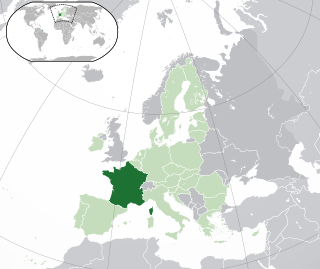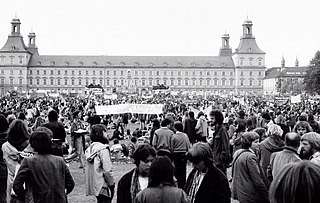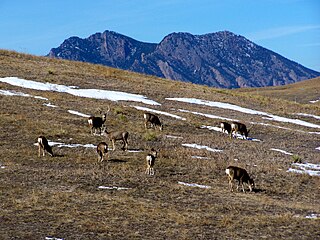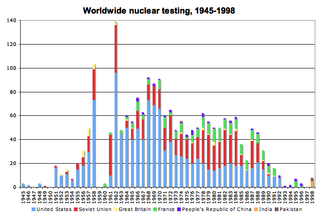Related Research Articles

Nuclear disarmament is the act of reducing or eliminating nuclear weapons. It can also be the end state of a nuclear-weapons-free world, in which nuclear weapons are completely eliminated. The term denuclearization is also used to describe the process leading to complete nuclear disarmament.

The Rocky Flats Plant was a U.S. manufacturing complex that produced nuclear weapons parts in the western United States, near Denver, Colorado. The facility's primary mission was the fabrication of plutonium pits, which were shipped to other facilities to be assembled into nuclear weapons. Operated from 1952 to 1992, the complex was under the control of the U.S. Atomic Energy Commission (AEC), succeeded by the Department of Energy (DOE) in 1977.

France is one of the five "Nuclear Weapons States" under the Treaty on the Non-Proliferation of Nuclear Weapons, but is not known to possess or develop any chemical or biological weapons. France was the fourth country to test an independently developed nuclear weapon in 1960, under the government of Charles de Gaulle. The French military is currently thought to retain a weapons stockpile of around 300 operational (deployed) nuclear warheads, making it the third-largest in the world, speaking in terms of warheads, not megatons. The weapons are part of the national Force de frappe, developed in the late 1950s and 1960s to give France the ability to distance itself from NATO while having a means of nuclear deterrence under sovereign control.

The anti-nuclear movement is a social movement that opposes various nuclear technologies. Some direct action groups, environmental movements, and professional organisations have identified themselves with the movement at the local, national, or international level. Major anti-nuclear groups include Campaign for Nuclear Disarmament, Friends of the Earth, Greenpeace, International Physicians for the Prevention of Nuclear War, Peace Action and the Nuclear Information and Resource Service. The initial objective of the movement was nuclear disarmament, though since the late 1960s opposition has included the use of nuclear power. Many anti-nuclear groups oppose both nuclear power and nuclear weapons. The formation of green parties in the 1970s and 1980s was often a direct result of anti-nuclear politics.

The anti-nuclear movement in the United States consists of more than 80 anti-nuclear groups that oppose nuclear power, nuclear weapons, and/or uranium mining. These have included the Abalone Alliance, Clamshell Alliance, Committee for Nuclear Responsibility, Nevada Desert Experience, Nuclear Information and Resource Service, Physicians for Social Responsibility, Plowshares Movement, Women Strike for Peace, and Women's International League for Peace and Freedom. The anti-nuclear movement has delayed construction or halted commitments to build some new nuclear plants, and has pressured the Nuclear Regulatory Commission to enforce and strengthen the safety regulations for nuclear power plants.

Nuclear weapons testing, uranium mining and export, and nuclear power have often been the subject of public debate in Australia, and the anti-nuclear movement in Australia has a long history. Its origins date back to the 1972–73 debate over French nuclear testing in the Pacific and the 1976–77 debate about uranium mining in Australia.
The 1970s proved to be a pivotal period for the anti-nuclear movement in California. Opposition to nuclear power in California coincided with the growth of the country's environmental movement. Opposition to nuclear power increased when President Richard Nixon called for the construction of 1000 nuclear plants by the year 2000.

The Rocky Flats National Wildlife Refuge is 5,237-acre (21.19 km2) National Wildlife Refuge in the United States, located approximately 16 miles (26 km) northwest of Denver, Colorado. The refuge is situated west of the cities of Broomfield and Westminster and situated north of the city of Arvada.
Anti-nuclear organizations may oppose uranium mining, nuclear power, and/or nuclear weapons. Anti-nuclear groups have undertaken public protests and acts of civil disobedience which have included occupations of nuclear plant sites. Some of the most influential groups in the anti-nuclear movement have had members who were elite scientists, including several Nobel Laureates and many nuclear physicists.

The anti-nuclear movement in the United Kingdom consists of groups who oppose nuclear technologies such as nuclear power and nuclear weapons. Many different groups and individuals have been involved in anti-nuclear demonstrations and protests over the years.

A peace movement is a social movement that seeks to achieve ideals such as the ending of a particular war, minimize inter-human violence in a particular place or type of situation, and is often linked to the goal of achieving world peace. Means to achieve these ends include advocacy of pacifism, non-violent resistance, diplomacy, boycotts, peace camps, moral purchasing, supporting anti-war political candidates, legislation to remove the profit from government contracts to the Military–industrial complex, banning guns, creating open government and transparency tools, direct democracy, supporting Whistleblowers who expose War-Crimes or conspiracies to create wars, demonstrations, and national political lobbying groups to create legislation. The political cooperative is an example of an organization that seeks to merge all peace movement organizations and green organizations, which may have some diverse goals, but all of whom have the common goal of peace and humane sustainability. A concern of some peace activists is the challenge of attaining peace when those that oppose it often use violence as their means of communication and empowerment.

Throughout the previous decades anti-nuclear protests in the United States have been a force to be reckoned with as well as a contributing factor in keeping the American public informed on the anti-nuclear movement in the United States. These included the well-known Clamshell Alliance protests at Seabrook Station Nuclear Power Plant and the Abalone Alliance protests at Diablo Canyon Nuclear Power Plant, where thousands of protesters were arrested. Other large protests followed the 1979 Three Mile Island accident.
Making a Real Killing: Rocky Flats and the Nuclear West is a 1999 book by Len Ackland. Ackland draws on information obtained from governmental sources, federal contractors, personal interviews, and newspaper articles to form a multi-layered history about the controversial Rocky Flats nuclear facility. The book also explores the creation and collapse of the nuclear weapons complex in the United States.

Anti-nuclear protests began on a small scale in the U.S. as early as 1946 in response to Operation Crossroads. Large scale anti-nuclear protests first emerged in the mid-1950s in Japan in the wake of the March 1954 Lucky Dragon Incident. August 1955 saw the first meeting of the World Conference against Atomic and Hydrogen Bombs, which had around 3,000 participants from Japan and other nations. Protests began in Britain in the late 1950s and early 1960s. In the United Kingdom, the first Aldermaston March, organised by the Campaign for Nuclear Disarmament, took place in 1958. In 1961, at the height of the Cold War, about 50,000 women brought together by Women Strike for Peace marched in 60 cities in the United States to demonstrate against nuclear weapons. In 1964, Peace Marches in several Australian capital cities featured "Ban the Bomb" placards.

Kristen Iversen is an American writer of nonfiction and fiction. Her books include Full Body Burden: Growing Up in the Nuclear Shadow of Rocky Flats, Molly Brown: Unraveling the Myth and Shadow Boxing: Art and Craft in Creative Nonfiction. She is a Professor in English and Creative Writing at the University of Cincinnati and Literary Nonfiction Editor of The Cincinnati Review. Iversen will be a Fulbright Scholar at the University of Bergen, Norway in 2020-2021.
James Peck was an American activist who practiced nonviolent resistance during World War II and in the Civil Rights Movement. He is the only person who participated in both the Journey of Reconciliation (1947) and the first Freedom Ride of 1961, and has been called a white civil rights hero. Peck advocated nonviolent civil disobedience throughout his life, and was arrested more than 60 times between the 1930s and 1980s.

The application of nuclear technology, both as a source of energy and as an instrument of war, has been controversial.

The Rocky Flats Plant was a U.S. nuclear weapons production facility about 15 miles (24 km) northwest of Denver. Weapons production was permanently halted after years of protests followed by a combined FBI and Environmental Protection Agency raid in 1989 on the allegation of environmental crimes. Summarizing outcomes for the facility, a criminal investigation followed by grand jury charges against the site's contractor-manager ensued, the plant was shut down, and the buildings demolished and removed from the site. The contractor pleaded guilty to environmental crimes, and was punitively fined the highest hazardous-waste penalty ever at the time, four times higher than any previous amount.
Candelas is the largest master-planned community in Arvada, Colorado. The residential portion of the community is developed by Terra Causa Capital and GF Properties Group, with residences built by Century Communities, Richmond American, Ryland Homes, Standard Pacific Homes, Village Homes, and various custom builders. Plans exist for commercial development in the future, in the form of two mixed-use commercial spaces, and a town center, comprising some 7.1 million square feet of commerce in the community. The formal plat was filed with the Jefferson County Recorder on April 21, 2011.
References
- ↑ Ann Morrissett Davidon (December 1979). "The U.S. Anti-nuclear Movement". Bulletin of the Atomic Scientists. p. 46.
- ↑ http://www.boulderweekly.com/news/27-years-of-activism/